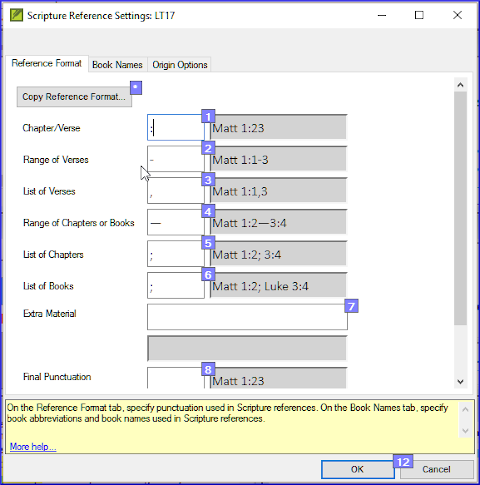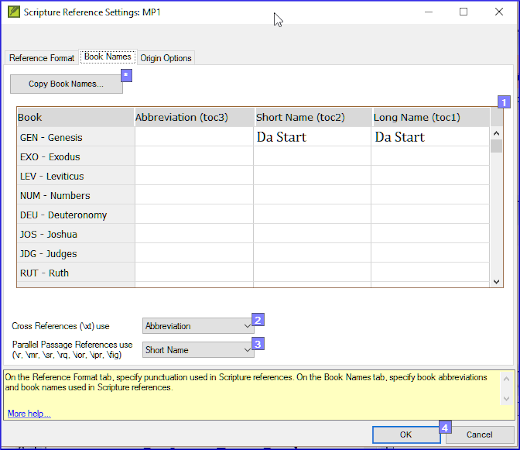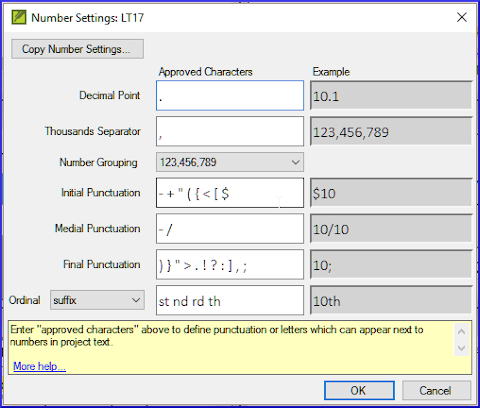19. Basic checks 3
Introduction In this module you will learn how to run the remaining basic checks (references, quoted text, numbers, punctuation in pairs and quotations). As in the first two basic checks modules, it is easier to run the checks from Assignments and Progress. However, if you want to check more than one book then you need to run the checks from the checking menu.
Before you start You have typed your translation into Paratext. Make sure you have done the checks described in modules BC1 and BC2 before continuing. And that either your administrator has done the setup for the checks or is available to do the setup with you.
Why this is important Paratext has eleven basic checks. You have already seen the first six checks. This last set of checks helps you find errors related to material referred from other books. You want to be sure the references are accurate so that the reader can find those passages.
What you are going to do As before, most of the checks require your administrator to do some setup. In this module you will:
- Confirm that the setup is done
- Run the basic check
- Correct any errors.
19.1 Unmatched pairs of Punctuation
This check looks at punctuation that occurs in pairs (opening and closing) and lists errors where it is not matched by the other half of the pair. This may be deliberate but is more likely to be an error, e.g. ( ), [ ], etc.
Setup – inventory
- ≡ Tab, under Tools > Checking Inventories > Unmatched pairs of punctuation:
- If the list is empty, then there are no errors.
- If necessary, click Options… to add other pairs.
- Click OK.
Run the check
- ≡ Tab, under Tools > Run Basic Checks
- Check “Unmatched pairs of punctuation”
- Click OK
- A list of errors is displayed.
- Make any corrections as needed.
19.2 References
Settings
Before you can run the references check, your Administrator must define various settings.
≡ Tab, under Project > Scripture reference settings
For each setting, type the punctuation in the box
- The sample will be updated on the right.

Book names
Click the Book names tab
Fill-in the three columns [1] with abbreviation, short name and long name.
Choose Abbreviations [2] and [3] for both cross-references and references
Click OK.
- Paratext will update the \toc fields in the text.

Paratext will inform you if there are any inconsistencies between these book name settings and the \toc lines and will advise you to Resolve conflicts. This needs to be done by the Administrator.
Check
- ≡ Tab, under Tools > Run Basic Checks
- Click References
- Click OK
- Correct any errors.
19.3 Numbers check
Settings
Before you can run the numbers check, your Administrator must define various number settings.
≡ Tab, under Project settings > Number settings
Fill in the dialog box with the correct information.
Click OK.

You may need to remove unneeded items.
Check
- ≡ Tab, under Tools > Run basic checks
- Click Numbers
- Click OK
19.4 Quotation
The quotations check ensures you have been consistent in marking the direct speech correctly. It only checks the quotations you have marked.
The new "Quotation Types" Basic Check knows where quotations should occur in the text based on Glyssen (audio script) data and can ensure that they are all marked appropriately. It is more advanced than this course. But if you want more details, watch the video on Quotation Types in Paratext 9.4.
Settings
Before you can run the quotation check, your Administrator must define the rules for your quotations.
- ≡ Tab, under Project settings > Quotation rules
- Fill-in the quotation marks used for each level [1] - [9]
- Check Flag all quotes near other errors [12]
- Click OK.
Quotation check
- ≡ Tab, under Tools > Run basic checks
- Quotations
- Click OK.
- A list of errors is displayed. It also includes four correct quotations before and after the possible error.
- Double-click the first item which doesn’t start with …
- Correct as necessary.
- Click the Rerun button to confirm you have corrected the error.
19.5 Footnote Quotes
The Footnote quotes check (previously Quoted text) looks at text in a footnote (after the \fk or the \fq marker) or in a cross-reference (after the \xk or the \xq marker) to make sure it matches text in the verse where the footnote or cross-reference is located.
- ≡ Tab, under Tools > Run basic checks
- Footnote Quotes
- Click OK.
- A list of errors is displayed.
- Make corrections as needed.